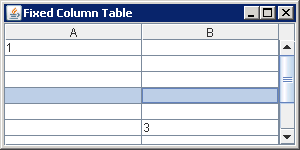
import java.awt.BorderLayout;
import java.awt.Point;
import java.util.HashMap;
import java.util.Map;
import javax.swing.JFrame;
import javax.swing.JScrollPane;
import javax.swing.JTable;
import javax.swing.table.AbstractTableModel;
import javax.swing.table.TableModel;
class SparseTableModel extends AbstractTableModel {
private Map<Point, Object> lookup;
private final int rows;
private final int columns;
private final String headers[];
public SparseTableModel(int rows, String columnHeaders[]) {
this.rows = rows;
this.columns = columnHeaders.length;
headers = columnHeaders;
lookup = new HashMap<Point, Object>();
}
public int getColumnCount() {
return columns;
}
public int getRowCount() {
return rows;
}
public String getColumnName(int column) {
return headers[column];
}
public Object getValueAt(int row, int column) {
return lookup.get(new Point(row, column));
}
public void setValueAt(Object value, int row, int column) {
if ((rows < 0) || (columns < 0)) {
throw new IllegalArgumentException("Invalid row/column setting");
}
if ((row < rows) && (column < columns)) {
lookup.put(new Point(row, column), value);
}
}
}
public class SparseTableModelDemo {
public static void main(String[] a) {
String headers[] = { "A", "B" };
TableModel model = new SparseTableModel(10, headers);
JTable table = new JTable(model);
model.setValueAt("1", 0, 0);
model.setValueAt("2", 9, 0);
model.setValueAt("3", 5, 1);
model.setValueAt("4", 8, 1);
JFrame frame = new JFrame("Fixed Column Table");
frame.setDefaultCloseOperation(JFrame.EXIT_ON_CLOSE);
frame.add(new JScrollPane(table), BorderLayout.CENTER);
frame.setSize(300, 150);
frame.setVisible(true);
}
}